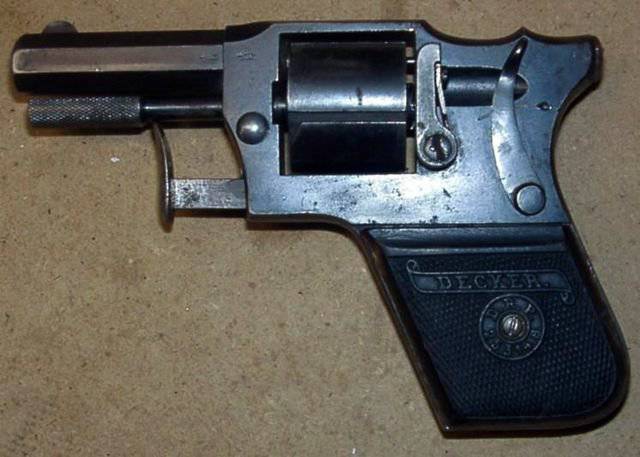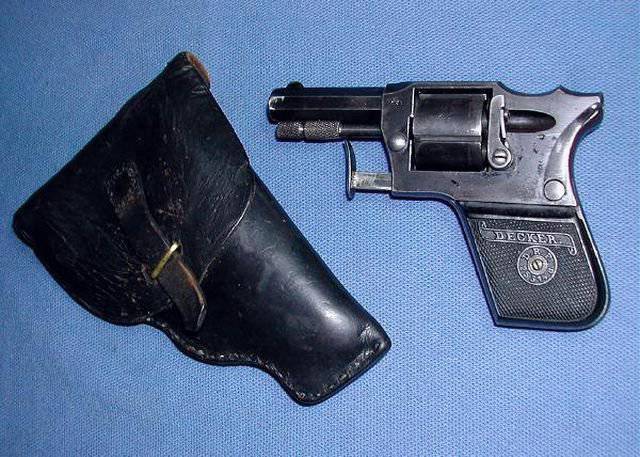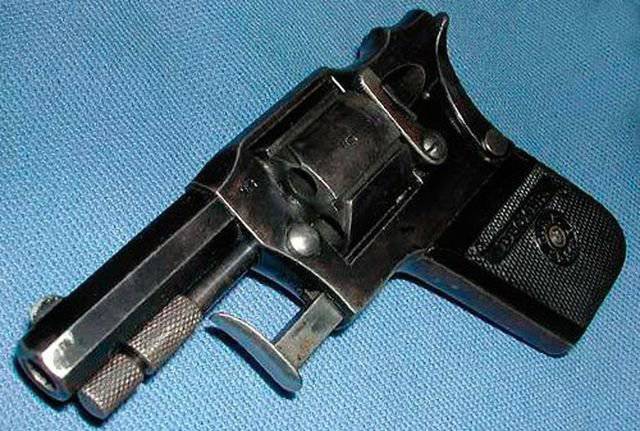Decker's Pocket Revolver
For quite a long time, the existence of various manual firearms weapons a huge number of samples and models were created. Many of these means of destroying their own kind were, to put it mildly, unusual. Some ideas of designers were so successful that they are still used, while other ideas, although they had obvious advantages, remained less popular or completely forgotten. Many samples of small arms remained forever only in the form of experimental samples or models that were released in minimal quantities and now represent a tasty morsel for private small arms collectors and museums of the world.
One of such samples is Decker's pocket-sized revolver, created on the threshold of the First World War. Six-compact compact revolver was equipped with solid steel frame. In the front plate was drilled channel for the axis of the drum. In the upper strap there was a groove for the rear sight. On the left side is a groove for loading the drum. The barrel of the revolver is steel, screwed into the frame, faceted in cross section, and has a solid milling front sight. The drum is cylindrical, also steel, it has 6 charging chambers and a central hole for its axis.

The revolver was equipped with a dead-end trigger mechanism, which allowed firing only by the self-intake. To the trigger of a revolver, a sufficiently long trigger lever was attached, which passed under a six-drum reel. At the moment when the shooter pressed the trigger, the lever moved back, and the drum dog lifted upward, ensuring the drum was rotated one step. At that moment, when the drum was fixed in the firing position, the trigger lever cocked and then the drummer lowered.
From the possibility of accidentally firing the arrow protected the mechanical fuse. The fuse box was located on the left side of the revolver. When it was turned on, it would block the triggering thrust. The shooter charged Decker's pocket-sized revolver through a special door that was located on the left side of the frame. Through the same door with the help of a ramrod-ejector, which was located inside the hollow axis of the drum, the spent cartridges were extracted.
On the right side of the frame of the revolver there was a special thin metal shield with a rectangular cutout in its upper part. This shield served important functions: it kept the cartridges in the drum, and also served as a protection against the rotating drum for the index finger arrow. It was the flap that gave Decker's revolver a more streamlined shape. It was quite important, as it provided quick and easy removal of weapons from the pocket.

The revolver was equipped with open unregulated sights, which consisted of a pillar in the form of a longitudinal groove on the upper surface of the frame and a semicircular front sight. Fake cheeks on the handle had a small notch and were made of plastic. At the same time, they were marked in the form of the name of the revolver “Decker”, the number of the patent issued to the weapon “DRP 253148” could also be affixed. On the upper surface of the frame, the patent number of the weapon was also put, as well as its caliber - the inscription “CALIBER 6.35”.
One of the features of the revolver was extremely low weight. Without ammunition, this sample of small arms of the beginning of the century weighed just 225 grams, which can be considered a kind of record. The length of its barrel was only 50 mm, and the total length of the revolver was equal to 118 mm. Despite its small size, the weapon was completely made of steel, no cases of destruction of the revolver in the process of shooting were recorded. Such modest dimensions made the weapon a toy rather than a combat pistol. It could not be considered a good means of self-defense, despite the simplicity of the design and its reliability. His ammunition was weak and was characterized by low lethal force.
In principle, on the basis of this model in the future it would be possible to create a more sophisticated revolver with new ammunition and larger dimensions, but this did not happen. The reason was not the growing popularity of shop pistols, but the unleashing of the First World War, in which such weak civilian weapons simply could not find a place. Indeed, this gun had very modest characteristics and efficiency. Because of this, just before the war, only a very limited number of these revolvers were released.

Mass production began immediately before the start of World War I, and already in 1914, it was stopped. In addition to Germany, a number of Dekker's revolvers were manufactured in the UK, where they were assembled by RH Mueller of London, which produced revolvers under the Mueller Special Revolver brand. At the same time, up to now, not a single English-style Decker revolver has been preserved. Most likely, in the UK, their units were collected. A small series of revolvers produced made this weapon a rare visitor to museum collections and private weapon collections.
Performance characteristics of Dekker's revolver:
Caliber - 6,35 mm.
Used cartridge - Browning 6,35-mm.
Overall length - 118 mm.
Barrel length - 50 mm.
Drum capacity - 6 cartridges.
Mass revolver without cartridges - 225 g.
Information sources:
http://gunsite.narod.ru/decker.htm
http://weaponland.ru/load/revolver_decker/147-1-0-887
http://www.fastmarksman.ru/D.htm
Information